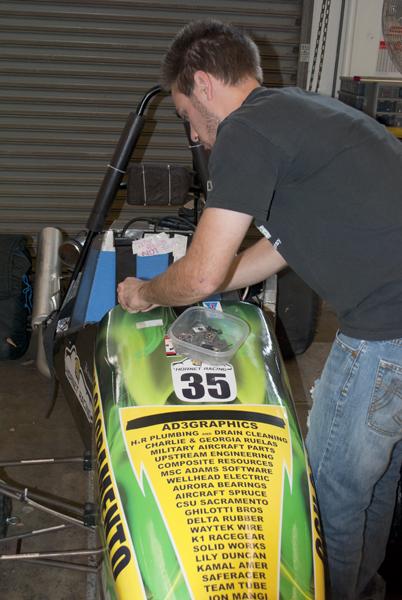Hornet Racing Club working on new car

Brandon Munoz, junior, mechanical engineering major, re-attaches the hood of the HR 2010 vehicle. Munoz is one of the main drivers of the HR 2010. The HR 2010 was built by the Hornet Racing Club in 2010.
November 2, 2011
Unlike previous years, the Sacramento State Hornet Racing Club will be building a race car from scratch to compete in next year’s Formula Society of Automotive Engineers competition.
Formula SAE is a student design competition organized by SAE International, which was also formerly known as the Society of Automotive Engineers. Each student team designs, builds and tests a small Formula-style racing car.
The Hornet Racing Club at Sac State is a club that helps engineering students in applying what they learn in the classroom through hands-on activities, in this case helping to build and design a race car.
Hornet Racing is looking to improve on last year’s event when it placed 44th out of 80. However, the team was able to finish the race, which is something it has not done in five years. Right now, the team is in the early stages of production for this year’s race car, and team member Marcos Navarro said it is going to be a long process.
“There’s a ton of work to do because this year we are building the car from the ground up instead of changing parts up,” Navarro said. “There’s going to be improvements everywhere.”
A four-cylinder, 599cc, 75-horsepower engine will be powering the new racing car. That is just under the legal limit of 610cc. The previously used engine came from a 2001 Honda CBR 600 motorcycle and cost the team $900. A new engine would have cost around $3,500.
Powertrain lead engineer Dan Ciobanu said the engine is a good fit.
“This engine has the best characteristics of power, affordability and reliability,” Ciobanu said. “It survives a lot abuse.”
Turbochargers or superchargers are allowed in competition as long as the team designs them. They cannot use engines with a turbocharger that have already been equipped with a supercharger. Ryan Hart, who is in charge of data acquisition, said it would not be that much of an advantage.
“No turbo or supercharger; we feel it adds too much weight for no power gain based on the way the rules are written,” Hart said. “If we had more money and the right facilities, we would consider a much lighter single cylinder or V-twin to turbocharge.”
Ciobanu said it takes about a year to finish building the car and having a sufficient amount of time for testing is crucial.
“One to three months doing the calculations and design, another one to two months of actually working on the car,” Ciobanu said. “Ideally, we want to have three months of testing in case certain things on the car do not work out.”
By SAE rules, each team has a choice of using a different kind of gasoline. Either regular unleaded gasoline or Ethanol-85, which contains the same type of alcohol that is found in alcoholic beverages. Using E-85 reduces carbon-monoxide emissions and provides significant reductions in emissions of many harmful toxins.
It took about $21,000 for Hornet Racing to build its 2011 race car, but about $11,000 for the 2010 car.
Stephanie Palmer, senior mechanical engineering major, is in charge of marketing and said at least $40,000 is needed for a decent car.
“The goal for this year is to bring the team up to that level. Our current estimations for the 2012 vehicle is that it’s cash value will be $45,000,” Palmer said. “What it will be in the end is directly determined by how many people and companies we can get as sponsors and if they are willing to give the club money, discounts or free parts.”
The club received some grants from the university and grants from the Associated Students Inc. called Dollars for Organizations and Clubs. ASI serves as the official governing body of Sac State students and sponsorship of programs. The rest of the money is received through fundraising and donations, but they insist on not asking the team members to pitch in.
“We don’t really ask of them to donate. We try to run it as a business,” Hart said.
After all the hard work is done, the next step for the team is to compete in Formula SAE competitions where many schools around the world attend.
The first stage is the technical inspection when judges check the car for any leaks, if the brakes work properly and if the car has not violated any rules. The second stage is the static event, where teams make a short presentation on the design aspect of the car and it is worth 150 points.
They also make a presentation, worth 100 points, on why they used the parts they did. The last presentation in the static event is a business presentation where the team attempts to convince a panel of judges to invest in their vehicle – fictitiously; this stage is worth 75 points.
The final stage is the Dynamic events, worth 675 points overall, where the teams finally put its race cars on the track. In this event, the car is tested on acceleration, fuel economy and endurance.
“Many cars do not finish this event. We were 1 of 30 to do so in 2011 out of the 80 entrants,” Hart said.
The team has two drivers, Ciobanu and Brandon Muenos, but said they are still looking to add a couple more.
“We need more and will be looking to identify and train talent sometime next semester,” Hart said.
The team is now working on the calculations and design for the car and are looking to finish in the time for the Lincoln event in June 2012. Hornet Racing Club meets on Thursdays at 5:30 p.m. in Riverside Hall, Room 1003.
Daniel Morales can be reached at [email protected].




























































































































